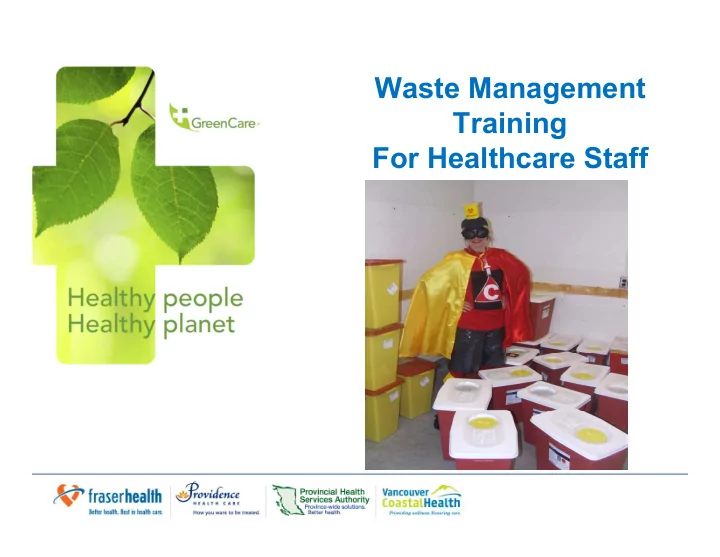

Waste Management Training For Healthcare Staff
Disclaimer Please note: content in this presentation is accurate for VCH, PHC, FHA and PHSA owned and operated sites; for other sites/health authorities, practice may vary depending on logistics, contracts for service vendors and end disposal vendors, etc. If you are not part of VCH, PHC, FHA or PHSA, please contact your Hazardous Waste Management person for questions, clarifications, documentation, etc. Thank you!
Health Care Waste Colour Coding Health care waste must be properly segregated before being sent for disposal or recycling. Non-Anatomical Autoclave Sharps Landfill Anatomical Incinerate Cytotoxic Pharmaceutical Recycling Recycle Confidential Garbage Landfill/ Incinerate
Non‐Anatomical Waste (autoclave) Any items saturated with, dripping with, or containing blood or body fluids containing blood Reusable container Requires yellow liner 4
Sharps Waste (autoclave) Items capable of cutting or puncturing the skin and that have come into contact with blood, body fluids or microorganisms Should never be lined One time use container Never use for other purposes 5
Garbage Items Containing PPI (autoclave) Garbage items containing Personal Patient Information which can identify a patient Remove PPI when possible If PPI cannot be removed dispose of item as non- anatomical biomedical waste Confidential paper Confidential mixed media Non-anatomical waste container (yellow liner) (not sharps container) 6
Items With Biohazard Symbols (autoclave) Do Not throw empty, broken, or unused items containing a Biohazard symbol into the garbage or recycling. Garbage Recycling Non-anatomical waste container (yellow liner) (not sharps container) 7
Anatomical Waste (incineration) Human and animal tissue Organs Body Parts Includes – excess tissue from surgical procedures, and bone . Does not require a liner, - best practice is no liner Red liner may be used for spill/smell prevention One time use container 8
Cytotoxic Waste (incineration) Waste that has come into contact with Cytotoxic Agents Cytotoxic Sharps Containers (should never be lined) Does not require liner (may be used for spill/smell prevention) If liner used (red only) One time use red container - must contain universal Cytotoxic “C” Unit staff must seal prior to pick up for disposal 9
Garbage Waste (landfill/incinerate) Items that are not “Recyclable” and that are not “Biomedical” waste Reusable container Requires black/green liner
Glass Only Waste (landfill/incinerate) A non-disposable rigid container or disposable cardboard box Double lined with black or dark green liners Dispose as garbage waste 11
Health Care Recycling • Recycling in health care facilities is different from in a home or office. • Health care facilities generate biomedical waste, so the recyclables pose a higher risk to recycling vendor staff that sort items by hand . • Due to the risks associated with health care recycling, our vendor will not accept any items they perceive as potentially harmful to their staff. The picture can't be displayed.
Health Care Recycling • Our vendor does not accept the following items for recycling, under any circumstances: × Biomedical Waste and Sharps × Medical Vials × Diapers (Soiled or Unused) × IV Bags × Urinals/Graduated Cylinders × Gloves × Syringes without needles × Items with Biohazard Symbols × Specimen Containers × Glass (apart from Food/Beverage) × Tubing × Plastic Bags × Plastic containers that have held corrosive materials
Health Care Recycling Contamination happens! •Needles, full blood bags, and suction containers with body fluid have been sent to our recycling vendor in the past
Mixed Container Recycling Recycling must be collected in blue slim jims or desk side bins. Clear liners are used to visually check recycling contents. 15
Mixed Paper Recycling Recycling must be collected in blue slim jims or desk side bins. Clear liners are used to visually check recycling contents. 16
Refundable Beverage Containers Recycling Recycling must be collected in blue slim jims or desk side bins. Clear liners are used to visually check recycling contents. 17
Actions To Reduce Contamination Always pair biomedical and recycling containers beside a garbage container when space permits (Exception: sharps containers) Never place biomedical containers of any type directly above or beside recycling containers. If this is not possible Place a garbage container in between biomedical and recycling containers Place recycling containers at least a foot away from biomedical containers Never place recycling in high contamination risk areas (i.e., ED Trauma rooms) This will improve segregation and prevent contamination 18
Recommend
More recommend